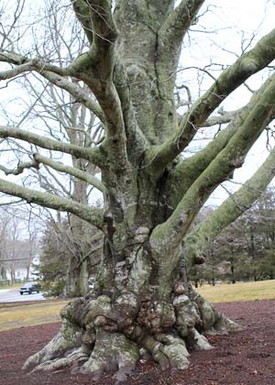 In January, the winter is cold and bleak. One looks out and sees stark trees, leafless and bare. The urban forest is all around us. And as each tree in it bares its soul. it tells us of its vigor to survive.
In January, the winter is cold and bleak. One looks out and sees stark trees, leafless and bare. The urban forest is all around us. And as each tree in it bares its soul. it tells us of its vigor to survive.
We watch these woods fill up with snow. It bends big branches and leans on huge tree trunks. Winter’s weight of ice and snow threatens both these woods and our safety.
Trees do not live forever. As they age, weak crotches, decayed insides, bad structure, damaged roots take their toll. Unbalanced big branches are the most dangerous part of trees, especially when weighted with snow and ice. Wind just compounds the risk.
Electric outages are the most common result. Roads blocked by blowdown trees are all too common. More dangerous are tree parts breaking the roof, falling on the car and the driveway.
What to do? First take a good look at your trees, stark, leafless and bare. Then think about any unbalanced or overhanging parts that could fall. Call the town tree warden or a Massachusetts Certified Arborist to get a safety opinion.
Most important, do not attempt to remedy the situation yourself. Not on a ladder. Not climbing the tree. And never, never use a power saw above your shoulder height while standing on the ground. In fact, one shouldn’t use a power saw at all unless one has taken many hours of training.
Tree pruning is a very, very dangerous profession. My Tree Care Industry Magazine lists the people killed each and every month in accidents. Any there are many, both trained professionals and ordinary civilians.
However there is some dormant pruning that can be done in winter, when plants are dormant. It is of small trees and overgrown shrubs. One can easily see the branches, reach them with a hand saw or pruning shears, and not ruin the plants underneath which are protected with snow cover.
1. What to Do: Shape and train plants. Restrict growth (particularly blocking windows.) Head back outlying growth, where needed, for better balance. Improve the main structure for future strength and safety. Remove V shaped unions or completely subordinate one side.
2. What to Prune: Remove deadwood. Prune crossing and rubbing branches and ones growing inward. Remove water sprouts and suckers.
3. What to Beware of Cutting: Flowering buds on branches that bloom in spring. (Rhododendrons, azaleas, viburnum, deciduous shrubs, flowering trees like magnolia, cherry, dogwood, apple, lilacs, and more). But cut forsythia now and bring it to bloom indoors. You can easily tell a flower bud because it is fatter than a leafing bud. If you aren’t sure, wait until June.
4. Hedges: This is not a bad time to prune if you are bored. There may be a little tip death, but it can be trimmed out later. This is also a good time to rejuvenate and cut some way back, even to about 8 inches. They take about a year to come back.
5. Then Stop and Look Around: Watch your woods fill up with snow. Your woods are lovely, dark and deep. Enjoy the urban forest, parks and trees and search the hidden promises they keep.
Credit: www.mothersgarden.net




























